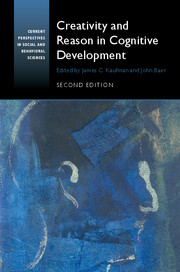Book contents
- Frontmatter
- Dedication
- Contents
- List of Contributors
- Acknowledgments
- 1 Creativity, Reason and Cognitive Development: Ten Years Later
- SECTION ONE CREATIVITY AND REASON IN CHILDHOOD AND THE SCHOOLS
- SECTION TWO CREATIVITY AND REASON IN COGNITION AND NEUROSCIENCE
- SECTION THREE CREATIVITY AND REASON: INTERACTIONS AND RELATED CONSTRUCTS
- 14 Opening up Creativity: The Lenses of Axis and Focus
- 15 Creativity and Reason: Friends or Foes?
- 16 Creative Self-Beliefs: Their Nature, Development, and Correlates
- 17 Individual Differences in Intelligence, Personality, and Creativity
- 18 An Update on “Does Culture Always Matter”: For Creativity, Yes, for Deductive Reasoning, No!
- Author Index
- Subject Index
- References
18 - An Update on “Does Culture Always Matter”: For Creativity, Yes, for Deductive Reasoning, No!
from SECTION THREE - CREATIVITY AND REASON: INTERACTIONS AND RELATED CONSTRUCTS
Published online by Cambridge University Press: 05 February 2016
- Frontmatter
- Dedication
- Contents
- List of Contributors
- Acknowledgments
- 1 Creativity, Reason and Cognitive Development: Ten Years Later
- SECTION ONE CREATIVITY AND REASON IN CHILDHOOD AND THE SCHOOLS
- SECTION TWO CREATIVITY AND REASON IN COGNITION AND NEUROSCIENCE
- SECTION THREE CREATIVITY AND REASON: INTERACTIONS AND RELATED CONSTRUCTS
- 14 Opening up Creativity: The Lenses of Axis and Focus
- 15 Creativity and Reason: Friends or Foes?
- 16 Creative Self-Beliefs: Their Nature, Development, and Correlates
- 17 Individual Differences in Intelligence, Personality, and Creativity
- 18 An Update on “Does Culture Always Matter”: For Creativity, Yes, for Deductive Reasoning, No!
- Author Index
- Subject Index
- References
Summary
The work of Nisbett, Peng, Choi, and Norenzayan (2001) on culture and systems of thought has drawn much attention from psychologists. The authors presented a strong and provocative view of cultural influence on human cognition. According to Nisbett et al., culture can influence not only our belief systems, languages, and social cognitive systems, but also the very basic cognitive processes of how we perceive and think. Their paper reviewed studies showing how culture penetrated almost every aspect of our cognitive processing, such as focus of attention, cognitive control, knowledge acquisition, attribution, prediction and “post-diction” (ad hoc explanation), reasoning, cognitive styles, categorization, judgment, and problem solving.
Is the influence of culture on cognition as pervasive as Nisbett et al. suggested? In this chapter, we examine the extent of cultural influence on human thinking by focusing on two types of thinking: deductive reasoning and creativity, which are both fundamental human abilities but are commonly considered different cognitive processes.
To many psychologists, deductive reasoning and creativity are like two antitheses, representing two modes of thinking (e.g., de Bono, 1991; Johnson-Laird, 1987, 1993; Lavric, Forstmeier, & Rippon, 2000; Runco, 2002; Sternberg & O'Hara, 1999). Johnson-Laird (1987) once stated that the cognitive process of human creativity was beyond a scientific explanation, and certainly different from that of logical reasoning. De Bono (1991), who invented the terms vertical and lateral thinking, roughly paralleling the contrast between analytical and creative thinking, made clear distinctions between these two modes of thinking. According to de Bono, while vertical thinking proceeds along well-established patterns, follows a closed procedure, and promises a minimal result, lateral thinking seeks to avoid the obvious, has open-ended maximum solutions, and promises no single correct result.
Sternberg (1997a, 2012), in his successful intelligence theory, advocated that there were three aspects of intelligence: analytical, creative, and practical. Those three aspects can be independent from each other, such that a person strong in one aspect may not be necessarily strong in the other two.
As an important factor in individual differences, culture stands out as a crucial next step to be examined. A significant number of studies to date have explored cultural influence on deductive reasoning and creativity, but most focused on just one cognitive process. As critical as this topic is, the existing evidence is far from adequate. Therefore cultural influence on these two important modes of thinking deserves more attention.
- Type
- Chapter
- Information
- Creativity and Reason in Cognitive Development , pp. 354 - 378Publisher: Cambridge University PressPrint publication year: 2016



